Ware C. Information Visualization: Perception for Design
Подождите немного. Документ загружается.

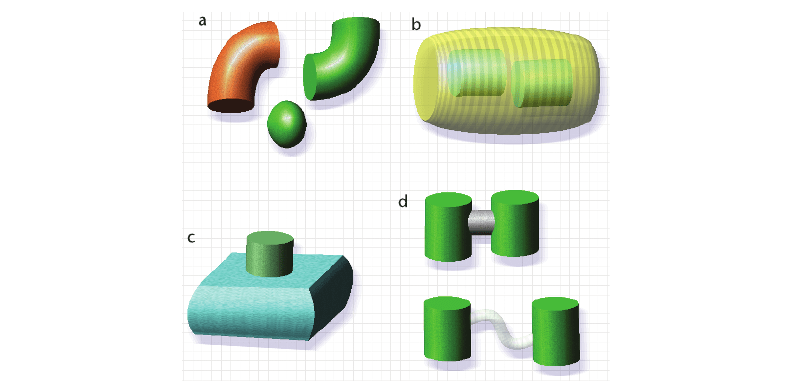
we can decompose such a landscape into features such as hills and valleys, these are not
essential to perceiving the shape of any given area of the surface. Examples of continuous surfaces
that are important in visualization include digital elevation maps representing the topography of
the land or the ocean floor, maps of physical properties of the environment, such as pressure and
temperature, and maps representing mathematical functions that are only distantly related to the
raw data. The general terms for this class of data object are two-dimensional scalar field and uni-
variate map. The two traditional methods for displaying scalar field information are the contour
map, which originated in cartography, and the pseudocolor map, discussed in Chapter 4.
Spatial Cues for Representing Scalar Fields
From a Gibsonian point of view, the obvious way to represent a univariate map is to make it
into a physical surface in the environment. Some researchers occasionally do just this; they con-
struct plaster or foam models of data surfaces. But the next best thing may be to use computer
graphics techniques to shade the data surface with a simulated light source and give it a simu-
lated color and texture to make it look like a real physical surface. Such a simulated surface can
be viewed using a stereoscopic viewing apparatus, by creating different perspective images, one
for each eye. These techniques have become so successful that the auto industry is using them to
design car bodies in place of the full-sized clay models that were once constructed by hand to
show the curves of a design. The results have been huge cost savings and a considerably accel-
erated design process.
244 INFORMATION VISUALIZATION: PERCEPTION FOR DESIGN
Figure 7.14 Certain spatial relationships between objects can readily represent abstract concepts. (a) That objects
belong to the same class is better shown by shape than by color. (b) A part-of relationship. (c) A
dependency relationship. (d) Strong and weak relationships.
ARE7 1/20/04 5:57 PM Page 244
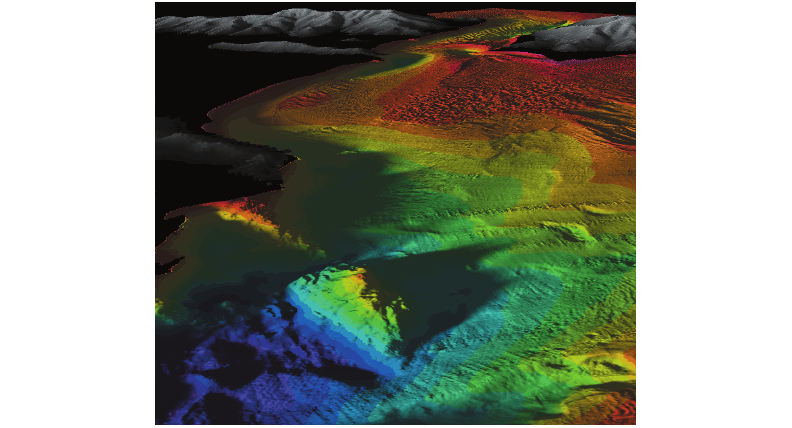
An important issue in the creation of univariate maps is determining how to represent surface
shape most effectively. Four principal sets of visual cues for surface shape perception have been
studied: shading models, surface texture, stereoscopic depth, and motion parallax.
Shading Models
The basic shading model used in computer graphics to represent the interaction of light with sur-
faces has already been discussed in Chapter 2. It has four basic components, as follows:
Lambertian shading: Light reflected from a surface equally in all directions
Specular shading: The highlights reflected from a glossy surface
Ambient shading: Light coming from the surrounding environment
Cast shadows: Shadows cast by an object, either on itself or on other objects
Figure 7.15 illustrates the shading model, complete with cast shadows, applied to a digital ele-
vation map of San Francisco Bay. As can be seen, even this simple lighting model is capable of
producing a dramatic image of a surface topography. A key question in choosing a shading model
for data visualization is not its degree of realism, but how well it reveals the surface shape. There
is some evidence that more sophisticated lighting may be harmful in representing surfaces.
Visual Objects and Data Objects 245
Figure 7.15 A shaded representation of San Francisco Bay, shown as if the water had been drained out of it. Data
courtesy of Jim Gardiner, U.S. Geological Survey. Image constructed using IVS Fledermaus software.
ARE7 1/20/04 5:57 PM Page 245
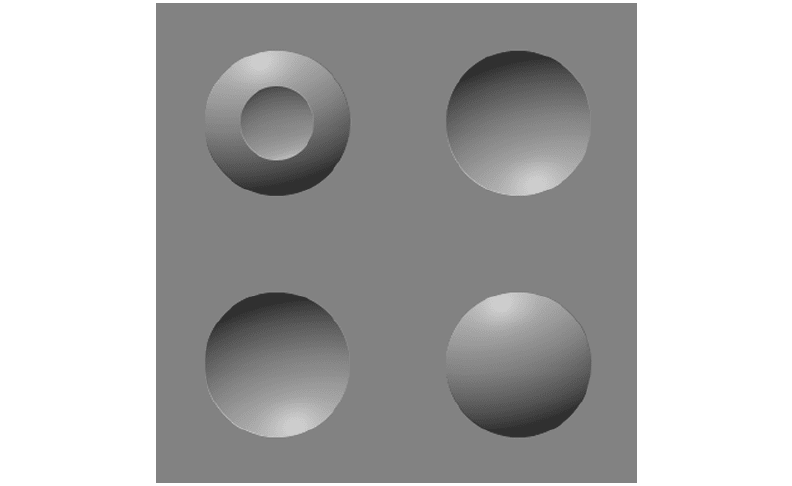
246 INFORMATION VISUALIZATION: PERCEPTION FOR DESIGN
Experiments by Ramachandran (1988) suggest that the brain assumes a single light source from
above in determining whether a particular shaded area is a bump or a hollow. (See Figure 7.16.)
The kinds of complex shadows that result from multiple light sources and radiosity modeling
may be visually confusing rather than helpful. Chapter 8 presents evidence that cast shadows
provide spatial information relevant to the layout of objects in space rather than their surface
shapes.
Surface Texture
Surfaces in nature are generally textured. Gibson (1986) took the position that surface texture
is an essential property of a surface. A nontextured surface, he said, is merely a patch of light.
The way in which textures wrap around surfaces can provide valuable information about surface
shape.
Texturing surfaces is especially important when they are viewed stereoscopically. This
becomes obvious if we consider that a uniform nontextured polygon contains no internal stereo-
scopic information about the surface it represents. Under uniform lighting conditions, such a
surface also contains no orientation information. When a polygon is textured, every texture
Figure 7.16 The brain generally assumes that lighting comes from above. The bumps in this image become hollows
when the picture is turned upside down.
ARE7 1/20/04 5:57 PM Page 246

element provides stereoscopic depth information relative to neighboring points. Figure 7.17
shows a stereoscopic pair of images representing a textured surface.
Without texture, it is usually impossible to distinguish one transparent curved surface from
another transparent curved surface lying beneath it. Figure 7.18 shows an illustration from Inter-
rante et al. (1997) containing experimental see-through textures designed to reveal one curved
surface lying above another. The concept of laciness, discussed in Chapter 6, is relevant here,
because it tells us something about how to make layers visually distinct. Stereoscopic viewing
considerably enhances our ability to see one surface through another, semitransparent one.
Integration of Cues for Surface Shape
Given the many factors that may be involved in surface shape perception, the question arises as
to which of them are most helpful. To study this problem, Norman et al. (1995) used computer
graphics to render smoothly shaded rounded objects like the one shown in Figure 7.19. They
manipulated the entire list of variables given above—specular shading, Lambertian shading,
texture, stereo, and motion parallax—in a multifactor experiment. Stereo and motion were
studied only in combination with the other cues because without shading or texture, neither
stereo nor motion cues can be effective. The subjects’ task was to indicate surface orientation at
a number of selected points by manipulating the 3D glyph shown in Figure 7.20.
Norman et al. found all of the cues they studied to be useful in perceiving surface orienta-
tion, but the relative importance of the cues differed from one subject to another. For some sub-
jects, motion appeared to be the stronger cue; for others, stereo was stronger. A summary of their
results with motion and stereo data combined is given in Figure 7.21. Motion and stereo both
reduced errors dramatically when used in combination with any of the surface representations.
Overall, the combination of shading (either specular or Lambertian) with either stereo or motion
was either the best or nearly the best combination for all the subjects.
There have been other studies of the relative importance of different cues to the perception
of surface shape. Todd and Mingolla (1983) found surface texture to be more effective in deter-
mining surface shape than either Lambertian shading or specular shading. However, because of
the lack of a convincing general theory for the combination of spatial cues, it is difficult to gen-
eralize from experiments such as this. Many of the results may be valid only for specific textures
Visual Objects and Data Objects 247
Figure 7.17 A stereo pair showing a textured surface.
ARE7 1/20/04 5:57 PM Page 247
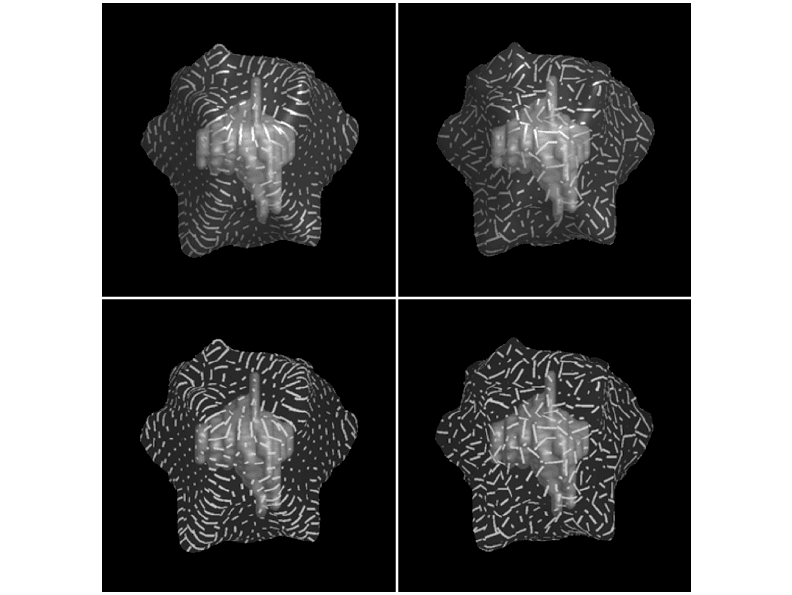
used, for example. The fact that there are large individual differences is another barrier to reach-
ing general conclusions. Random textures, such as those used by Norman et al. (1995), may not
be as effective in revealing shape as texture that follows the surface in some way (Interrante et
al., 1997; Kim et al., 1993). For these reasons, it is not meaningful to make general statements
such as “Lambertian shading is more useful than texture.” The values of the different cues will
also depend on the specific task. For example, specular highlights can be extremely useful in
revealing fine surface details, as when a light is used to show scratches on glass. At other times,
highlights will obscure patterns of surface color.
Interaction of Shading and Contour
The boundary contours of objects can interact with surface shading to change dramatically the
perception of surface shape. Figure 7.22 is adapted from Ramachandran (1988). It shows two
248 INFORMATION VISUALIZATION: PERCEPTION FOR DESIGN
Figure 7.18 Texture designed to reveal surface shape. From Interrante et al. (1997).
ARE7 1/20/04 5:57 PM Page 248
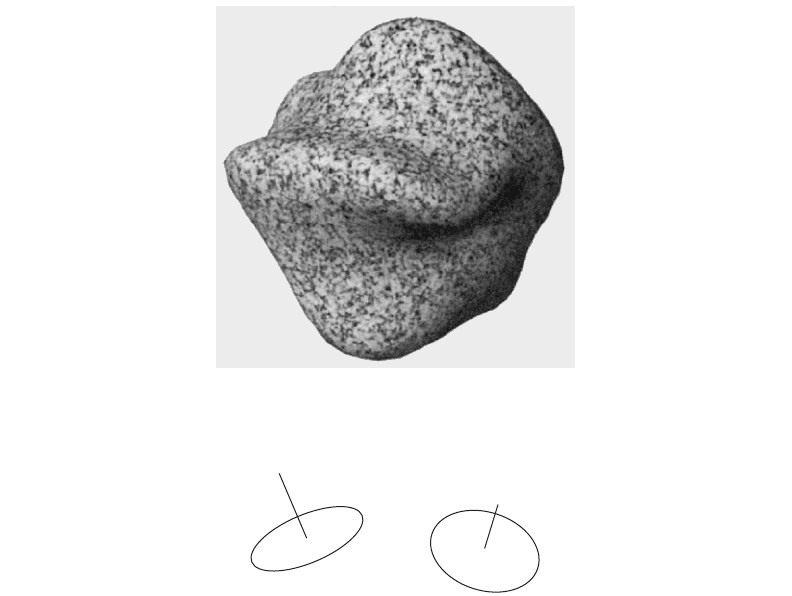
shapes that have exactly the same shading but different silhouette contours. The combination
of silhouette contour information with shading information is convincing in both cases, but
the surface shapes that are perceived are very different. This tells us that shape-from-shading
information is inherently ambiguous; it can be interpreted in different ways, depending on the
contours.
Contours that are drawn on a shaded surface can also drastically alter the perceived shape
of that surface. Figure 7.23 has added shaded bands that provide internal contour information.
As in Figure 7.22, the actual pattern of shading within each of the two images, and within the
bands, is the same. It is the contour information that makes one surface shape appear so differ-
ent from the other. This technique can be used directly in displaying shaded surfaces to make a
shape easier to perceive.
One of the most common ways to represent surfaces is to use a contour map. A contour
map is a plan view representation of a surface with isoheight contours, usually spaced at regular
Visual Objects and Data Objects 249
Figure 7.19 Textured, shaded, irregular objects were used by Norman et al. (1995) in experiments to determine which
visual information contributes most to the perception of surface shape.
Figure 7.20 Interactive glyph used by Norman et al. (1995) to measure perception of surface orientation.
ARE7 1/20/04 5:57 PM Page 249
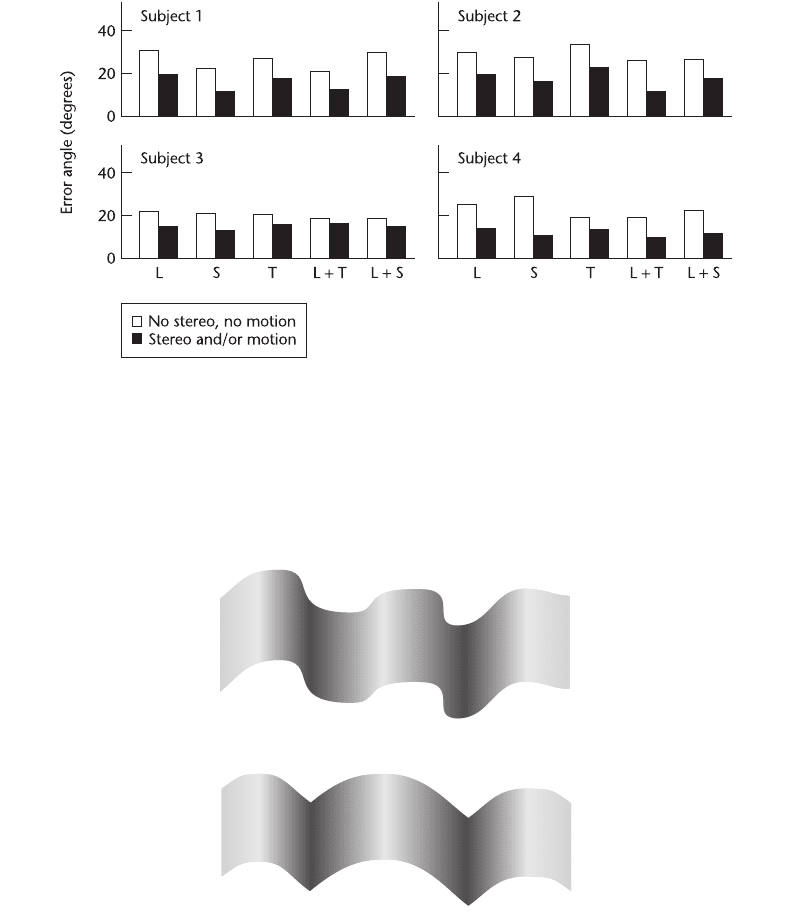
250 INFORMATION VISUALIZATION: PERCEPTION FOR DESIGN
Figure 7.21 Results of the study of shape perception by Norman et al. (1995). The average errors in adjusted
orientation are shown for five different surface representations. The different representations are labeled
as follows: (L) Lambertian shading, (S) specular highlight shading, (T) texture with no shading, (L + T)
Lambertian shading with texture, and (L + S) Lambertian shading with specular highlights. The four sets
of histograms represent results from four different subjects.
Figure 7.22 When scanned from left to right, the sequences of gray values in these two patterns are identical. The
external contour interacts with the shading information to produce the perception of two very differently
shaped surfaces.
ARE7 1/20/04 5:57 PM Page 250
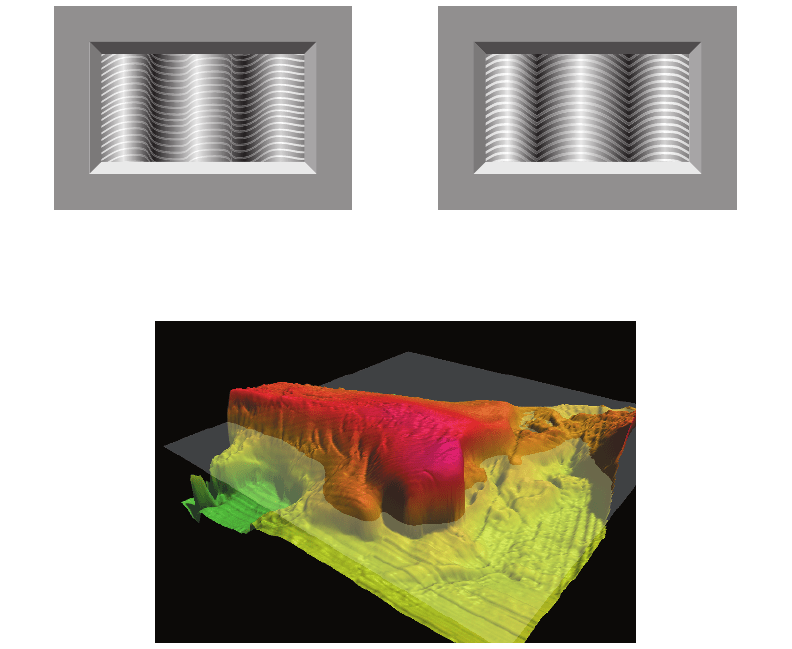
intervals. Conceptually, each contour can be thought of as the line of intersection of a horizon-
tal plane with a particular value in a scalar height field, as illustrated in Figure 7.24. Although
reading contour maps is a skill that requires practice and experience, contour maps should not
necessarily be regarded as entirely arbitrary graphical conventions. Contours are visually ambigu-
ous with respect to such things as degree of slope and direction of slope; this information is given
only in the printed labels that are attached to them. However, it is likely that the contours in
contour maps get at least some of their expressive power because they provide a limited per-
ceptual code. As we have seen, both occluding (silhouette) contours and surface contours are
effective in providing shape information. Although contour-map contours are not silhouettes,
they obey one of the cognitive restrictions that Marr (1982) proposed for occluding contours,
Visual Objects and Data Objects 251
Figure 7.23 The left-to-right gray sequence in these patterns is identical. The internal contours interact with the
shading information to produce the perception of two very differently shaped surfaces.
Figure 7.24 A contour is created by the intersection of a plane with a scalar field.
ARE7 1/20/04 5:57 PM Page 251
namely, that contours are assumed to be planar. They also provide texture gradient information.
Thus, contour maps are a good example of a hybrid code; they make use of a perceptual mech-
anism, and they are also partly conventional.
There are many ways to make oriented textures conform to a surface. Texture lines can be
constructed to follow the fall-line (down slope), to be horizontal contours, to be at right angles
to maximum curvature direction, or to be orthogonal to the line of site of a viewer, to present a
few examples. Kim et al. (1993) investigated combinations of first and second principal direc-
tions of curvature contours, as illustrated in Figure 7.25. All of the textured surfaces were arti-
ficially lit using standard computer graphics shading algorithms. Subjects made smaller errors in
surface orientation judgments when two contour directions were used to form a mesh, as in
Figure 7.25(a). Nevertheless, this study and Norman et al. (1995) found that errors averaged 20
degrees. This is surprisingly large and suggests that further gains are possible.
Guidelines for Displaying Surfaces
Taken together, the evidence suggests that to represent a surface clearly it may be possible to do
better than simply create a photorealistic rendering of a scene using the most sophisticated
techniques of computer graphics. A simplified lighting model—for example, a single light
source located at infinity—may be more effective than complex rendering using multiple
light sources. The importance of contours and the easy recognizability of cartoon representation
suggest that an image may be enhanced for display purposes by using techniques that are
nonrealistic.
Taking all these caveats into consideration, some guidelines may be useful for the typical
case:
1. A simple lighting model, based on a single light source, should normally be used. The
light source should be from above and to one side and infinitely distant.
2. Both Lambertian and moderate specular surface reflection should be modeled. More
sophisticated lighting modeling, such as the interreflection of light between surfaces,
should be avoided for reasons of clarity.
3. Specular reflection is especially useful in revealing fine surface detail. Because specular
reflection depends on both the viewpoint and the position of the light source, the user
should be given interactive control of the lighting direction, and the amount of specular
reflection to specify where the highlights will appear.
4. Cast shadows should be used if possible, but only if the shadows do not interfere with
other displayed information. The shadows should be computed to have blurred edges to
make a clear distinction between shadow and surface pigment changes.
5. Surfaces should be textured, especially if they are to be viewed in stereo. However, the
texturing should ideally be low-contrast so as not to interfere with shading information.
Textures that have linear components are more likely to reveal surface shape than textures
with randomly stippled patterns.
252 INFORMATION VISUALIZATION: PERCEPTION FOR DESIGN
ARE7 1/20/04 5:57 PM Page 252
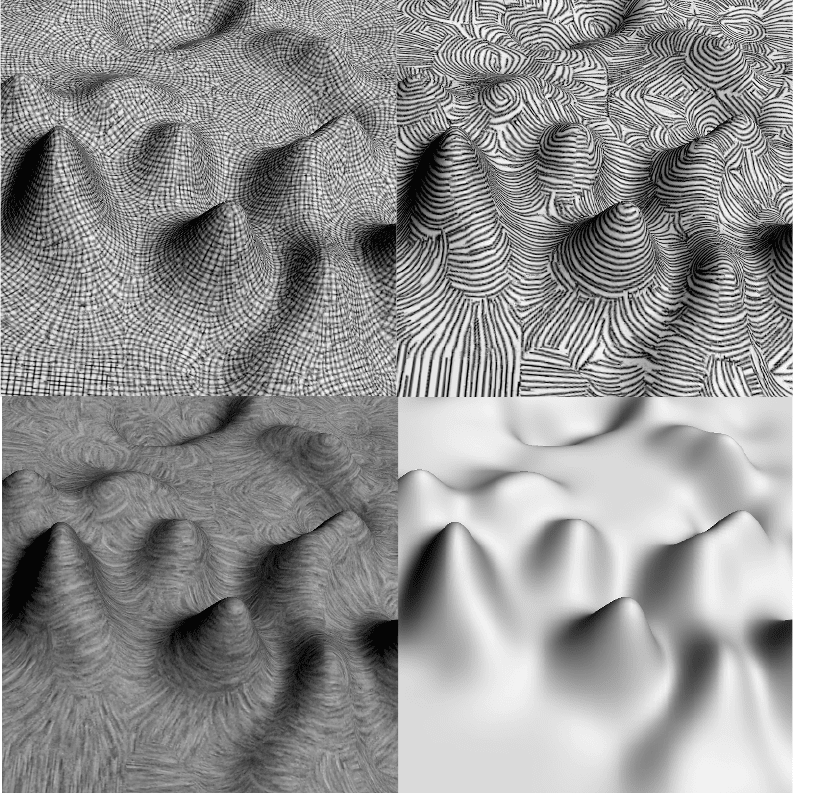
Visual Objects and Data Objects 253
a
b
c
d
Figure 7.25 Surface-revealing texture patterns (Kim et al., 2003). (a) Two-directional texture pattern following first
and second principal directions. (b) One-directional texture pattern following first principal curvature
direction. (c) One-directional line-integral convolutions texture following first principal curvature
direction. (d) No texture. Reproduced with permission.
ARE7 1/20/04 5:57 PM Page 253
